#and the way white womanhood has been historically constructed
Explore tagged Tumblr posts
Text
I'm know this sound hypocritical coming from me considering most of the stuff on my blog but I'm sure that both Ethel Cain and Fiona Apple hate a good chunk (wouldn't say the majority of their fandom but a significant and very loud part) of their fandom... So many of us behave in a way that Ethel Cain and Fiona apple have criticized and I feel kinda bad for them
like I don't think that Hayden is going "I love the way my fans are talking about dating older men and romanticizing their 3ds and other mental illnesses" lol (not a problem for me because I'm aroace but I do be romanticizing going to the great dark) and I don't think Fiona Apple is a big fan of the "I'm just a girl" thing that a weird amount of her new fans have been doing (and neither am I even if I do indulge in it)
I wonder how a part of their fandom can be so different from them and the views they hold and I think that this can be traced to how that part of the fandom tend to aestheticize their music and very rarely interact with their lyrics and interviews and what not.
once again I know how hypocritical this is coming from a blog that is mostly about my disordered eating but whatever
#i kinda include myself in that part of Ethel Cain fandom at time#I don't really listen to a lot of Fiona Apple so I wouldn't say that I'm a part of her fandom#Fiona Apple#Ethel cain#hayden anhedönia#mother cain#you guys should check out Hayden's YouTube channel it's so good#I particularly would recommend her video on the ring and proximity to god#it has changed the way I think about art and why I like some songs#it has also push me to listen more attentively to song I really like#i was talking to another black girl about why so many white girl were drawn to the “im just a girl” mentality compared to racialized women#and i genuinely believe a good part of it stems from white supremacy#and the way white womanhood has been historically constructed#black girlblogger
11 notes
·
View notes
Text
[id: the first image is a reply by @.demilypyro that reads: That doesnt sound very cis
the second image is a reply by @.homosexualmorelikehomiesexual that reads: respectfully adding to this in agreement with op: i think its true that no, it DOESNT sound very cis, but thats bc according to the very same gender system that sucks so much, anyone who disagrees or complains about it is Other, and i think thats......part of the exact problem op is talking abt..? so yeh idk. speaking as a trans person myself- op youre valid youre right and you should say it i support you go cis boy go
#this is what i call cis+ #youre cis but youve seen the void. the truth. and then you pulled back and went Ok Got It. Keeping My Gender Though #which i think is just as respectable. like amen #consciously opting into your assigned gender when you know you don’t actually have to..... #thats cis plus. cis prime. cis upgraded. you feel? /end]
I’m a cis man sure but i also wanna opt out of the gender binary. None of that shit is my fault or my responsibility and i don’t want any part of it
#text#lgbtag#may actually add something to the post eventually but it's late so just putting some thoughts in the tags#saying this as a trans genderfuck person . it's incredibly reductive to tell anyone who questions the gender binary or desires to break it-#-down that they Have to be trans to do so#you see it a lot with gnc cis people but tbh . applies to even gender conforming cis people and even non-queer cis people !#because in doing so you reinforce that trans people are Magically Different than cis people and that we're the only people who want to-#-question and break down the gender binary#but like . if you want to acknowledge that the gender binary is made up & people have complex relationships with it that fall outside of-#-the socially dictated binary & that ''man'' and ''woman'' are socially created categories not based in biology#and that there's no concrete definition of what a man or a woman or someone who's both or neither and etc beyond personal identity and-#-social category / cis-enforced societal roles#... you also have to realize that some people will break down the concept of the binary and recognize all of that . and still identify with-#-their assigned gender and be cis#expecting anyone who breaks down and rejects the gender binary to automatically also be trans not only cuts us off from cis allies who want-#-to help trans acceptance and break down those social structures#but also ignores intersectional groups who have complicated experiences with gender based on those identities while being cis!#(ex as a white person with privilege i don't feel confident speaking on it on my own but reading about black perspectives on gender and how-#-black women especially have historically been treated by largely white feminist movements how black women are degendered how the sex-#-binary has been leveraged in a racist & eugenics-based way etc imo is really important for breaking down the gender binary even when it's-#-discussing specifically cis people. bc discussions on marginalization are never in a vacuum)#and there are plenty of people Esp queer people who may not solidly fit in a cis or trans box esp when it comes to gnc people!#ex the amount of butch lesbians and fem/me gay men whose connection to womanhood or manhood is through being a lesbian/gay man#but who have more complex relationships with their gender and expression than Just womanhood or manhood#idk long rant and none of this is to say that there's a Cisphobic Trans Agenda to Force Poor Cis People to be trans bc a woman likes suits-#-or a man thinks the gender binary sucks#just . again as a trans person who experiences a lot of joy from my relationship to gender and being trans#i love seeing cis people who can find joy in their gender through breaking down the binary!#gender is complicated and i think accepting it as something Anyone can have a complex relationship . cis or trans . is a big part of-#-accepting that gender is a social construct and not a biological fact
143K notes
·
View notes
Text
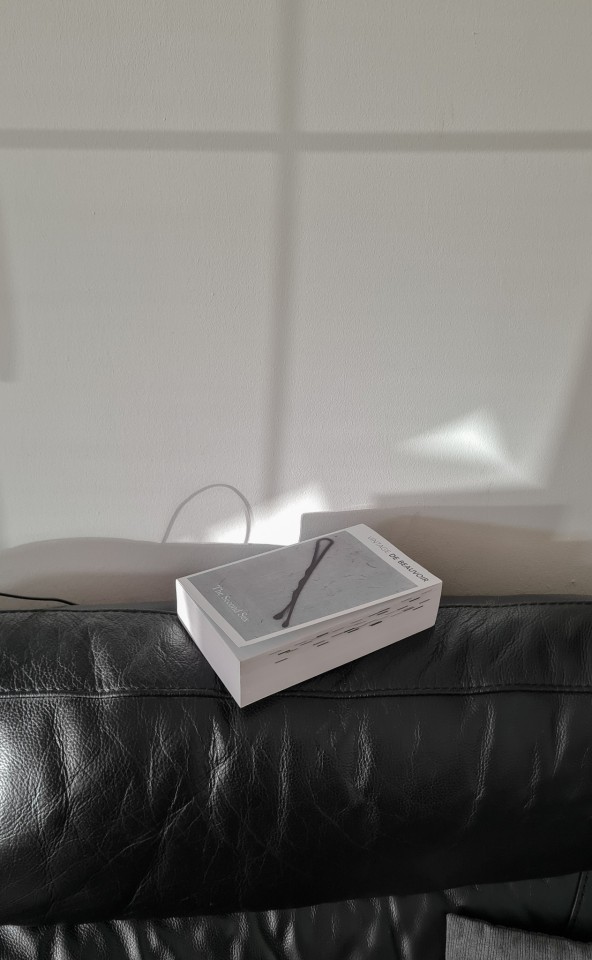

the second sex ; simone de beauvoir | part one
‘the second sex’ is a treatise on female autonomy. widely regarded as the blueprint for the second wave of feminism, this 900-page body of theory remains one of the most influential texts for women all over the globe. its impact is infinite, and beauvoir’s theory is masterfully cogent.
there’s a lot in here to reflect on and absorb. i’ve been tackling this absolute brick of a book by consuming 10 pages a day and allowing myself to really ruminate and sit with what beauvoir is putting out there. taking this book in small increments was definitely the way to go
simone de beauvoir begins by grappling with the question, ‘what is a woman?’ - an impossible question. woman is an ideal. a social reality and confinement the man constructs that pitches women in opposition to him as “the other”. womanhood is the condition in which a woman finds herself confirming a regulated hierarchy. however, beauvoir begins by answering this question through the biological. woman is a ‘womb, an ovary’. man reduces women to nature; they are mothers and reproductive catalysts. like the spider, she castrates and cannibalises; she consumes and eats men. beauvoir deconstructs the biological and the ways in which man has attributed inferiority to the natural biological difference between sexes.
biology, however, is not the foundation for womanhood. although it informs feminine existence, it isn’t the basis of gendered alterity and power disparity. beauvoir acknowledges biological subjugation while simultaneously stating that it is not reason enough for why women are the Other.
the question of ‘what is a woman?’ morphs into ‘what has humanity made of the human female?’ we must examine woman as a complete body, not in parts.
the concept of woman is examined from various schools of thought. from psychoanalysis - which is quickly proven insufficient due to freud’s misogynistic and male-oriented examination of sexual development, which is then generalised to women - to historical materialism and the role that economic value plays in female existence. beauvoir discusses engels - though classism is deeply connected to the disparity between sexes, it is not the origin of patriarchal oppression. female subordination pre-exists class divides. where the proletariat desires to erase class divisions, women do not want to be erased. we simply want to be registered in all forms. although the abolition of private property and class divisions is desirable, it will not ensure female liberation. and so, engels and marxism fail women.
this leads to a deconstruction of human history and the ways in which women were sacrificed on man’s journey for fulfilment and nourishment. as man went to hunt and build tools, women were frequently resigned to motherhood. as man conquer the world, women are left to watch from the sidelines. by dominating nature, man triumphs over woman. women become possessions like land. he is order and accomplishment; she is mystery and chaos.
as the socio-political landscape alters, the female condition continues to deteriorate. women face extreme abuse within the workforce, all for minuscule pay (and gender wage gaps DO still exist). this worsens with religion. simone de beauvoir delves into an array of theological beliefs - christianity, islam, and judaism being central focuses - and highlights the ways that each religion fails women. she also accounts for various cultural practises across the globe (from india to the mediterranean). this is very much a body of text that registers various different cultures and the nuances of each, respectively. i wish it reflected more on the nuances of non-white women’s existence within the western world, however.
i’ll end today’s overview with the most impactful line from this section for me - ‘women’s entire history has been written by men’. the problem of women has always been the problem of men. ‘it is not women’s inferiority that has determined their historical insignificance: it is their historical insignificance that has doomed them to inferiority’.
with man lies the onus for female suffering.
#the second sex#simone de beauvoir#reading update#literature aesthetics#books#book#bookish#bookblr#bookworm#bookstagram#dark academia#booklover#books and libraries#studyblr#study space#academia#study hard#study#movie#film#coffee and cigarettes#annotations#annotated books#cinema#beige#minimalism#feminist theory#feminism#studying#essay
80 notes
·
View notes
Text
https://www.insurrecthistory.com/archives/2022/01/10/i-always-dressed-this-way-surfacing-nineteenth-century-trans-history-through-mary-jones
“We know the lurid details of [Mary Jones’s] legal troubles made her a minor recurring figure in local newspapers during her life. One rare glimpse of her own voice comes from court testimony recorded during People vs. Sewally when she was asked why she wore women’s clothing. Jones explained:
“I have have been in the practice of waiting upon Girls of ill fame…they induced me to dress in Women’s Clothes, saying I looked so much better in them and I have always attended parties among the people of my own Colour dressed in this way – and in New Orleans I always dressed this way.”
But beyond the brief, strategically crafted narratives given in court, little of her life, thoughts, feelings, and relationships is known.
Jones’ interactions with the carceral system–and her intermittent, sensationalizedappearances in newspapers throughout the 1830’s to 50’s–must be understood within her specific historical context. The United States' growing urban populations, particularly in northeastern cities such as New York, rendered trans communities increasingly visible, inviting increasing public and political concern with crossdressing. A wave of anti-masquerade laws intended to forestall deceptions across racial lines were passed across the United States during Jones’ lifetime, including New York’s 1845 penal code 240.35(4); they were also quickly marshaled to harass trans people. In 1836, Jones was arrested for stealing the wallet of Robert Haslem, a white man who solicited her sex work. A lithograph published following her conviction for grand larceny depicts Jones as a beautiful woman, elegantly dressed and calmly side-eyeing the viewer. The caption describes her as “The MAN-MONSTER.”… a label that at once denies Jones’ womanhood by suturing her to the category “man” while excluding her from that category through the epithet “monster.”
The name “man-monster” places Jones at the nexus of two continuing histories of attempted dehumanization. Misogynoir constructs Black women as improperly feminine and therefore improperly human. Transmisogynist bigotry dehumanizes trans women by denying manhood and womanhood, thus rendering us neuter–an inhuman “it.” The archival objects that inform us about Jones bear witness to forms of oppression that continue to the present– to an intricate, pernicious, and ongoing mingling of racism, misogyny, and transphobia. The public mockery and carceral violence inflicted on Jones should be understood as analogous to the violent backlash against trans women of color that has followed our current moment of trans visibility – a backlash resulting in 2021 being the deadliest year for trans people on record in the United States. Justice demands that we remember the cruelties Jones suffered as we work to build a world that would make them truly locked in a historical past.”
29 notes
·
View notes
Text
By: Malcolm Clark
Published: Jul 18, 2023
The LGBT movement is beginning to behave more like a religious cult than a human-rights lobby. It’s not just the Salem-like witch hunts it pursues against its critics. It’s also its flight from reason and its embrace of magical thinking.
This irrationalism is best illustrated by its recent embrace of the term ‘two-spirit’ (often shortened to ‘2S’), which in North America has been added to the lobby’s ever-growing acronym, meaning we are now expected to refer to – take a deep breath – the ‘2SLGBTQQIA+ community’.
The term two-spirit was first formally endorsed at a conference of Native American gay activists in 1990 in Winnipeg in Canada. It is a catch-all term to cover over 150 different words used by the various Indian tribes to describe what we think of today as gay, trans or various forms of gender-bending, such as cross-dressing. Two-spirit people, the conference declared, combine the masculine and the feminine spirits in one.
From the start, the whole exercise reeked of mystical hooey. Myra Laramee, the woman who proposed the term in 1990, said it had been given to her by ancestor spirits who appeared to her in a dream. The spirits, she said, had both male and female faces.
Incredibly, three decades on, there are now celebrities and politicians who endorse the concept or even identify as two-spirit. The term has found its way into one of Joe Biden’s presidential proclamations and is a constant feature of Canadian premier Justin Trudeau’s doe-eyed bleating about ‘2SLGBTQQIA+ rights’.
The term’s success is no doubt due in part to white guilt. There is a tendency to associate anything Native American with a lost wisdom that is beyond whitey’s comprehension. Ever since Marlon Brando sent ‘Apache’ activist Sacheen Littlefeather to collect his Oscar in 1973, nothing has signalled ethical superiority as much as someone wearing a feather headdress.
The problem is that too many will believe almost any old guff they are told about Native Americans. This is an open invitation to fakery. Ms Littlefeather, for example, may have built a career as a symbol of Native American womanhood. But after her death last year, she was exposed as a member of one of the fastest growing tribes in North America: the Pretendians. Her real name was Marie Louise Cruz. She was born to a white mother and a Mexican father, and her supposed Indian heritage had just been made up.
Much of the fashionable two-spirit shtick is just as fake. For one thing, it’s presented as an acknowledgment of the respect Indian tribes allegedly showed individuals who were gender non-conforming. Yet many of the words that two-spirit effectively replaces are derogatory terms.
In truth, there was a startling range of attitudes to the ‘two-spirited’ among the more than 500 separate indigenous Native American tribes. Certain tribes may have been relaxed about, say, effeminate men. Others were not. In his history of homosexuality, The Construction of Homosexuality (1998), David Greenberg points out that those who are now being called ‘two spirit’ were ridiculed by the Papago, held in contempt by the Choctaws, disliked by the Cocopa, treated by the Seven Nations with ‘the most sovereign contempt’ and “derided” by the Sioux. In the case of the Yuma, who lived in what is now Colorado, the two-spirited were sometimes treated as rape objects for the young men of the tribe.
The contradictions and incoherence of the two-spirit label may be explained by an uncomfortable fact. The two-spirit project was shaped from day one by complete mumbo-jumbo. The 1990 conference that adopted the term was inspired by a seminal book, Living the Spirit: A Gay Indian Anthology, published two years earlier. Its essays were compiled and edited by a young white academic called Will Roscoe. He was the historical adviser to the conference. And his work on gay people in Indian cultural history – a niche genre in the 1980s – had become the received wisdom on the subject.
Roscoe’s work had an unlikely origin story of its own. In 1979, he joined over 200 other naked gay men in the Arizona desert for an event dubbed the ‘Spiritual Conference for Radical Faeries’. It was here where he met Harry Hay, the man who would become his spiritual mentor and whose biography he would go on to write. The event was Hay’s brainchild and was driven by his conviction that gay men’s lives had become spiritually empty and dominated by shallow consumerism. For three days, Roscoe and the other men sought spiritual renewal in meditation, singing and classes in Native American dancing. There were also classes in auto-fellatio, lest anyone doubt this was a gay men’s event.
To say Hay, who died in 2002, was eccentric is to radically understate his weirdness. For one thing, he was a vocal supporter of paedophilia. As such, he once took a sandwich board to a Pride march proclaiming ‘NAMBLA walks with me’, in reference to the paedophilia-advocacy group, the North American Man / Boy Love Association. Hay also believed that gay men were a distinct third gender who had been gifted shamanic powers. According to Hay, these powers were recognised and revered by pre-Christian peoples, from Ancient Greece to, you guessed it, the indigenous tribes of North America.
For years, Hay had been experimenting with sweat lodges and dressing up in Indian garb in ways that would now be criticised as cultural appropriation. Despite this, Roscoe took Hay’s incoherent thesis – that gender-bending and spiritual enlightenment go hand in hand – and turned it into a piece of Native American history.
Unsurprisingly, given its provenance, Roscoe’s work is full of holes and lazy assumptions. To prove that two-spirit people combine the feminine and masculine spirits, Roscoe searched for evidence of gender non-conforming behaviour among the Indian tribes. The problem was that he had to mainly rely on the accounts of white settlers who had little understanding of Native cultures. And even when he didn’t rely on those sources, Roscoe still jumped to the wrong conclusions.
Take, for example, the case of Running Eagle, ‘the virgin woman warrior’ of the Blackfeet tribe, whom Roscoe was the first to label as two-spirit. As a girl, she rebelled against the usual girl chores and insisted on being taught how to hunt and fight. She became a noted warrior and declared she would never marry a man or submit to one.
Of course, none of this really means that Running Eagle was two-spirit, or that the tribe she hailed from was made up of LGBT pioneers. It merely shows that the Blackfeet were smart and adaptable enough to recognise martial talent in a girl and were able to make good use of a remarkable individual. Nevertheless, Roscoe’s description of her has become gospel and Running Eagle is now endlessly cited as an example of a two-spirit.
This is a mind-numbingly reductive approach. It’s based on the presumption that what we think of as feminine and masculine traits are fixed and stable across time and cultures. It dictates that no Native American man or woman who ever breaks a gender taboo or fails to conform to expectations can be anything but two-spirit. This is gender policing on steroids.
The two-spirit term also does Native American cultures a deep disservice. It assumes that 500 different tribes were both homogenous and static. As journalist Mary Annette Pember, herself Ojibwe, argues, it also erases ‘distinct cultural and language differences that Native peoples hold crucial to their identity’.
In some ways, it is entirely unsurprising that the wayward ‘2SLGBTQQIA+’ movement has fastened on to two-spirit, an invented term with a bogus pedigree. Far from paying tribute to Native American cultures in all their richness, it exploits them to make a cheap political point. Harry Hay and his fellow auto-fellators would be proud.
==
"Two spirit" is a great way of fabricating an interesting identity when you don't have one. And you can scream at people as "bigots," but without the guilt of lying about your great-grandparents being descendants of Sacagawea.
The fake mysticism goes along neatly with the notion of disembodied sexed thetans ("gender identity") which become trapped between worlds in the wrong meat bodies.
#Malcolm Clark#two spirit#pretendians#native american#native american culture#noble savage#narcissism#narcissistic personality disorder#2SLGBTQ#gender ideology#queer theory#cultural appropriation#religion is a mental illness
67 notes
·
View notes
Text
in honor of this terf bullshit:

i'm adding my tags from this rb:
#thinking specifically about the Agojie who reportedly would say they had become men thru becoming warriors#& to be clear I'm not saying they are 1:1 w western transmascs#but it's telling to me that transmasculinity never comes up At All#people hear ''warrior women'' and only ever talk about cis women#idk why can't we entertain the idea that women who actively considered themselves to have become men#or been men in some way#mayve viewed their gender in a more complex way than just women?#you'll sometimes hear people bring up lesbians but never trans men. hmmm#it's almost like people view transmasculinity as a corrupting force which is existentially opposed to cis womanhood#it's just sooo fucking annoying seeing people never think at all abt the idea that if there is a role#where people assigned female can culturally masculinize themselves#maybe just maybe some of those women would not have identified with entirely ''cis'' womanhood?#like there had to be some people out there for whom the idea of becoming a man thru war was the point#I just wish people didn't act like you can either have Feminist Women in History or trans men but the two can't exist at once#like if any historical badass women were actually transmasc it's a Threat To Feminism#bc trans mens existence is only relevant in how cis women are affected by us
I am not saying all these people were trans men. I'm using "transmasculine" as a descriptor to group in things with a shared element (people assigned female socially/spiritually/physically masculinizing themselves in a way that changes their identity/place in culture) to relate it to trans activism.
my point is that cis is just as much a construct as trans is and we have a tendency to assume that every culture shares a cis-binary framework. gender is a construct and not every culture constructs it the same. when we see people assigned female in history, who culturally masculinize themselves, who do so to the extent they say they have become men, why do we reflexively assume that experiences is comparable to the way a cis woman in the US military or athlete understands her gender?
Oftentimes the most common ways we learn about "warrior women" is through cissexist and white-western storytelling. Nuanced cultural feelings about one's place in one's unique gender system are rarely not carried over. You know transmasculinity isn't gonna get brought up as even a consideration in most spaces. And also, I used the term "transmasculine" because women can be transmasculine. And I think with some "warrior women", even if they saw themselves as women on any level, it makes sense to connect that womanhood with transness. And also some of them likely would not identify themselves as "women", cis or not, in our binary language if they could.
And to be clear we do need so much nuance here wrt applying our labels, even categorically. Hapshetsut is a good example- yes, they portrayed themself as a man in art. but we also need to understand how ancient egyptians understood art as not a literal representation of the world around us and the ways that, within that society, a queen depicting herself as a man would not be understood in the same way we understand social transitioning of a trans man. i talked about the agojie not because they were just "women warriors" but because i literally read a quote where they explained their identity as "becoming men" and like. its deeply ethnocentric, imo, to assume that "becoming a man" has to mean the kind of physical transition we imagine. and especially since transmasculinity is reflexively erased in everything and even people who went to extreme lengths to be seen as a man and never a woman and out loud with their mouths said they identified as men are written as "women seeking safety/privilege." we should question why our understanding of gender & its connection to a certain bodytype is the default
whenever i look into cultural/historical third genders my first question is always "okay but where are the people who were assigned female" and my second is "if they aren't being named, why is that?"
6K notes
·
View notes
Text
i have to admit. i find the immediate shutdown of any discussion of misandry or oppression of men under the patriarchy by primarily white trans people extremely, frustratingly telling of how radfem talking points have been warped to fit into a trans inclusive worldview.
the idea that womanhood is the ultimate form of opression that overrides all other axes and that men unfailingly and inherently get nothing but benefits from the patriarchy are hallmarks of bioessentialist radical feminist thinking that has been used to exclude trans women from women's spaces for decades. but because people have realized it's less ok to be mask-off transphobic and a "feminist" at the same time, they reconcile this by redefining their gender categories to allow trans people to fit into the binary dynamic they've constructed.
this framework is, historically, painfully white, as it ignores the experiences of racialized men under racist cisheteropatriarchy and ignores a core aspect of intersectional theory- that you cannot tally up aspects of a person to place them somewhere on a singular continum of opression. the ways in which one is treated by society are made different by the overlap of one's identities, and it's stupid to argue over who's "more oppressed"- it's not comparable like that.
like. read "the will to change" by bell hooks and stop getting angry at people for discussing their own lived experiences please. dudes aren't opressing you by talking about how the patriarchy harms them. trans dudes aren't opressing you by talking abt how they get treated badly for being dudes.
0 notes
Text
Feminism and its waves
1st Wave
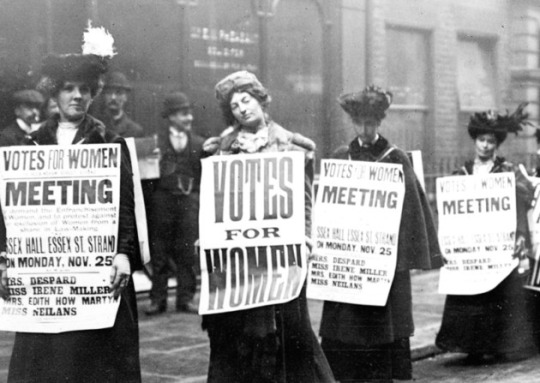
The first wave of feminism took place in the late nineteenth and early twentieth centuries, emerging out of an environment of urban industrialism and liberal, socialist politics. The goal of this wave was to open up opportunities for women, with a focus on suffrage. The wave formally began at the Seneca Falls Convention in 1848 when three hundred men and women rallied to the cause of equality for women. Elizabeth Cady Stanton (d.1902) drafted the Seneca Falls Declaration outlining the new movement's ideology and political strategies.
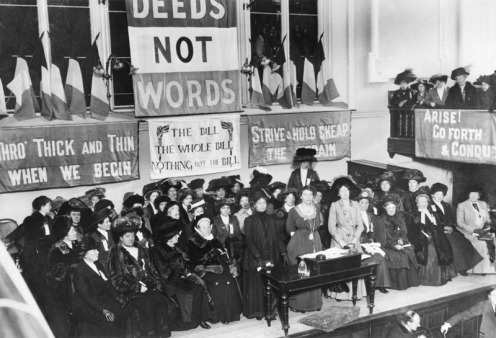
In its early stages, feminism was interrelated with the temperance and abolitionist movements and gave voice to now-famous activists like the African-American Sojourner Truth (d. 1883), who demanded: "Ain't I a woman?" Victorian America saw women acting in very "un-ladylike" ways (public speaking, demonstrating, stints in jail), which challenged the "cult of domesticity." Discussions about the vote and women's participation in politics led to an examination of the differences between men and women as they were then viewed. Some claimed that women were morally superior to men, and so their presence in the civic sphere would improve public behavior and the political process. (https://www.pacificu.edu/magazine/four-waves-feminism)
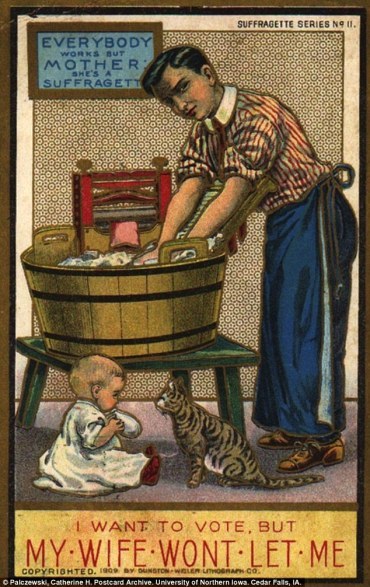
2nd Wave
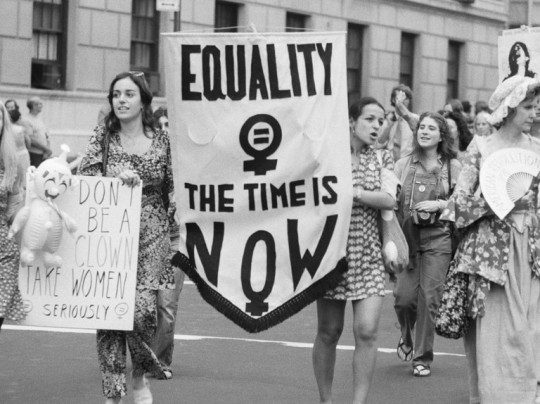
The second wave began in the 1960s and continued into the 90s. This wave unfolded in the context of the anti-war and civil rights movements and the growing self-consciousness of a variety of minority groups around the world. The New Left was on the rise, and the voice of the second wave was increasingly radical. In this phase, sexuality and reproductive rights were dominant issues, and much of the movement's energy was focused on passing the Equal Rights Amendment to the Constitution guaranteeing social equality regardless of sex.
This phase began with protests against the Miss America pageant in Atlantic City in 1968 and 1969. Feminists parodied what they held to be a degrading "cattle parade" that reduced women to objects of beauty dominated by a patriarchy that sought to keep them in the home or in dull, low-paying jobs. The radical New York group called the Redstockings staged a counter pageant in which they crowned a sheep as Miss America and threw "oppressive" feminine artifacts such as bras, girdles, high-heels, makeup and false eyelashes into the trashcan.
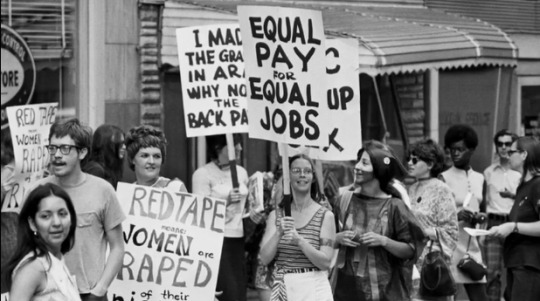
Because the second wave of feminism found voice amid so many other social movements, it was easily marginalized and viewed as less pressing than, for example, Black Power or efforts to end the war in Vietnam. Feminists reacted by forming women-only organizations (such as NOW) and "consciousness raising" groups. In publications like "The BITCH Manifesto" and "Sisterhood is Powerful," feminists advocated for their place in the sun. The second wave was increasingly theoretical, based on a fusion of neo-Marxism and psycho-analytical theory, and began to associate the subjugation of women with broader critiques of patriarchy, capitalism, normative heterosexuality, and the woman's role as wife and mother. Sex and gender were differentiated—the former being biological, and the later a social construct that varies culture-to-culture and over time.
Whereas the first wave of feminism was generally propelled by middle class, Western, cisgender, white women, the second phase drew in women of color and developing nations, seeking sisterhood and solidarity, claiming "Women's struggle is class struggle." Feminists spoke of women as a social class and coined phrases such as "the personal is political" and "identity politics" in an effort to demonstrate that race, class, and gender oppression are all related. They initiated a concentrated effort to rid society top-to-bottom of sexism, from children's cartoons to the highest levels of government.
One of the strains of this complex and diverse "wave" was the development of women-only spaces and the notion that women working together create a special dynamic that is not possible in mixed-groups, which would ultimately work for the betterment of the entire planet. Women, due whether to their long "subjugation" or to their biology, were thought by some to be more humane, collaborative, inclusive, peaceful, nurturing, democratic, and holistic in their approach to problem solving than men. The term eco-feminism was coined to capture the sense that because of their biological connection to earth and lunar cycles, women were natural advocates of environmentalism.(https://www.pacificu.edu/magazine/four-waves-feminism)
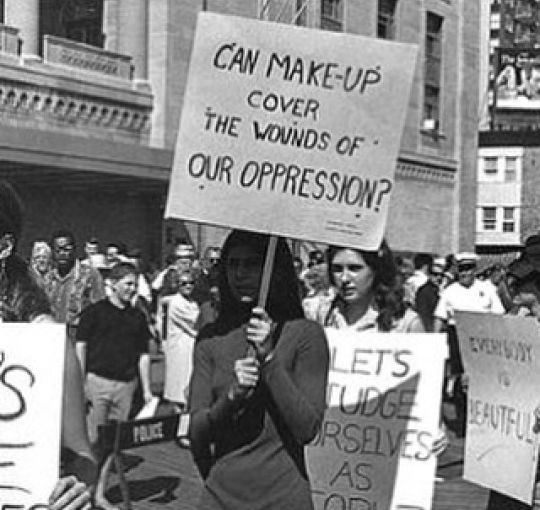
Critique to the 2nd wave: Some black and/or working class and poor women felt alienated by the main planks of the second-wave feminist movement, which largely advocated women's right to work outside the home and expansion of reproductive rights. Women of color and poor white women in the US had been working outside of the home in blue-collar and service jobs for generations. Additionally, Angela Davis wrote that while Afro-American women and white women were subjected to multiple unwilled pregnancies and had to clandestinely abort, Afro-American women were also suffering from compulsory sterilization programs that were not widely included in dialogue about reproductive justice.Beginning in the late 20th century, numerous feminist scholars such as Audre Lorde[118] and Winona LaDuke[119] critiqued the second wave in the United States as reducing feminist activity into a homogenized and whitewashed chronology of feminist history that ignores the voices and contributions of many women of color, working-class women, and LGBT women.[120][121]The second-wave feminist movement in the United States has been criticized for failing to acknowledge the struggles of women of color, and their voices were often silenced or ignored by white feminists.[122][120] It has been suggested that the dominant historical narratives of the feminist movement focuses on white, East Coast, and predominantly middle-class women and women's consciousness-raising groups, excluding the experiences and contributions of lesbians, women of color, and working-class and lower-class women.[43]Chela Sandoval called the dominant narratives of the women's liberation movement "hegemonic feminism" because it essentializes the feminist historiography to an exclusive population of women, which assumes that all women experience the same oppressions as the white, East Coast, and predominantly middle-class women.[123] This restricting view purportedly ignored the oppressions women face determined by their race, class, and sexuality, and gave rise to women-of-color feminisms that separated from the women's liberation movement, such as Black feminism, Africana womanism, and the Hijas de Cuauhtémoc that emerged at California State University, Long Beach, which was founded by Anna Nieto-Gómez, due to the Chicano Movement's sexism.[124][125][126]Kimberlé Crenshaw coined the term "intersectionality" in 1989 in response to the white, middle-class views that dominated second-wave feminism. Intersectionality describes the way systems of oppression (i.e. sexism, racism) have multiplicative, not additive, effects, on those who are multiply marginalized. It has become a core tenet of third-wave feminism.[127] (wikipedia)
Black Feminism
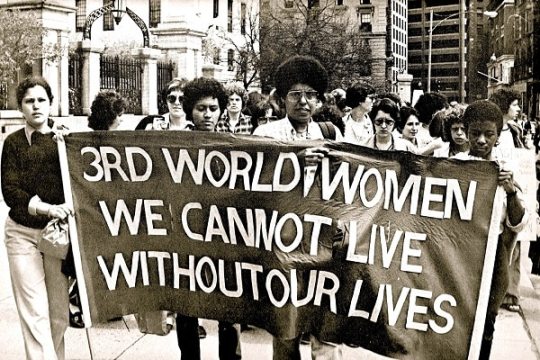
Black feminism holds that the experience of Black women gives rise to a particular understanding of their position in relation to sexism, class oppression, and racism.[1][2] The experience of being a Black woman, it maintains, cannot be grasped in terms of being Black or of being a woman but must be elucidated via intersectionality,[3] a term coined by legal scholar Kimberlé Crenshaw in 1989. Crenshaw argued that each concept—being Black and being female—should be considered independently while understanding that intersecting identities deepen and reinforce one anothe
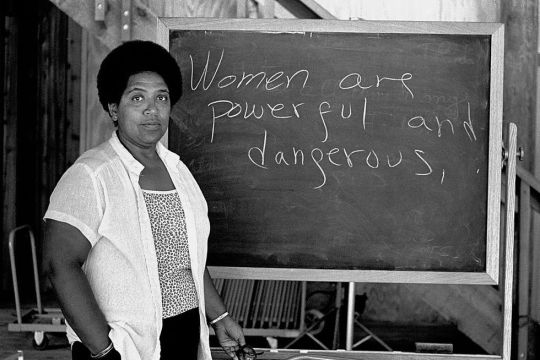
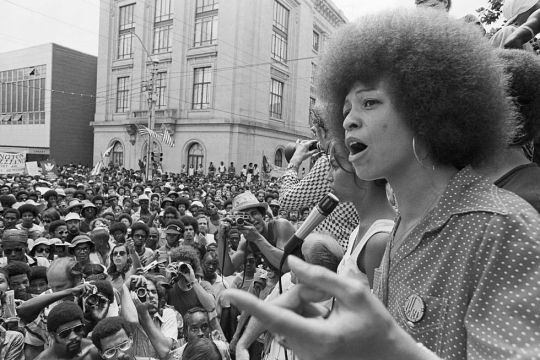
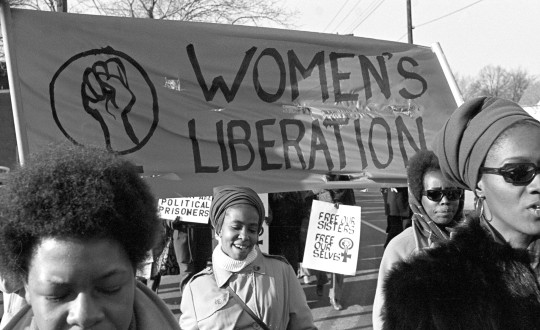
3rd WAVE
The third wave of feminism began in the mid-90's and was informed by post-colonial and post-modern thinking. In this phase many constructs were destabilized, including the notions of "universal womanhood," body, gender, sexuality and heteronormativity. An aspect of third wave feminism that mystified the mothers of the earlier feminist movement was the readoption by young feminists of the very lip-stick, high-heels, and cleavage proudly exposed by low cut necklines that the first two phases of the movement identified with male oppression. Pinkfloor expressed this new position when she said that it's possible to have a push-up bra and a brain at the same time.
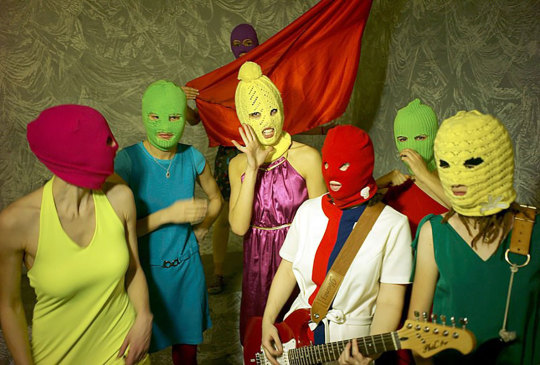

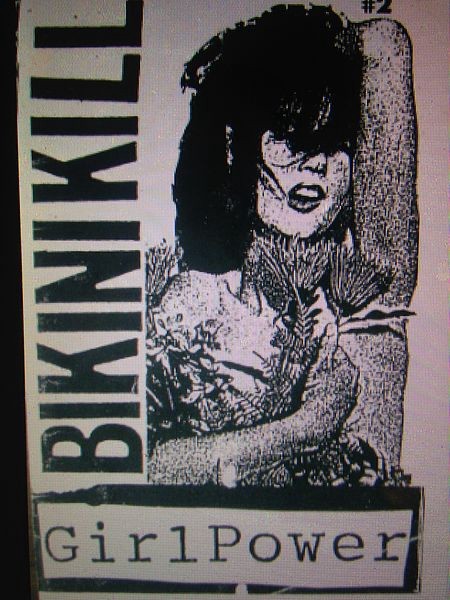
The "grrls" of the third wave stepped onto the stage as strong and empowered, eschewing victimization and defining feminine beauty for themselves as subjects, not as objects of a sexist patriarchy. They developed a rhetoric of mimicry, which appropriated derogatory terms like "slut" and "bitch" in order to subvert sexist culture and deprive it of verbal weapons. The web is an important tool of "girlie feminism." E-zines have provided "cybergrrls" and "netgrrls" another kind of women-only space. At the same time — rife with the irony of third-wave feminism because cyberspace is disembodied — it permits all users the opportunity to cross gender boundaries, and so the very notion of gender has been unbalanced in a way that encourages experimentation and creative thought.

This is in keeping with the third wave's celebration of ambiguity and refusal to think in terms of "us-them." Most third-wavers refuse to identify as "feminists" and reject the word that they find limiting and exclusionary. Grrl-feminism tends to be global, multi-cultural, and it shuns simple answers or artificial categories of identity, gender, and sexuality. Its transversal politics means that differences such as those of ethnicity, class, sexual orientation, etc. are celebrated and recognized as dynamic, situational, and provisional. Reality is conceived not so much in terms of fixed structures and power relations, but in terms of performance within contingencies. Third wave feminism breaks boundaries.
(https://www.pacificu.edu/magazine/four-waves-feminism)
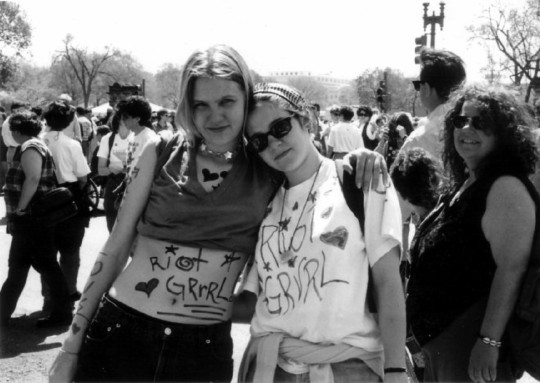
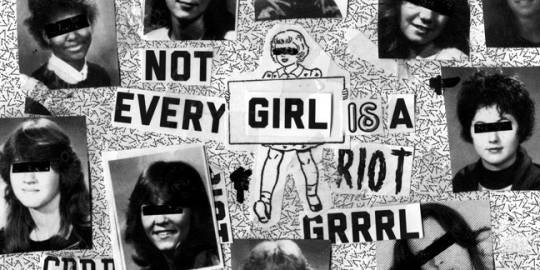
4th WAVE -
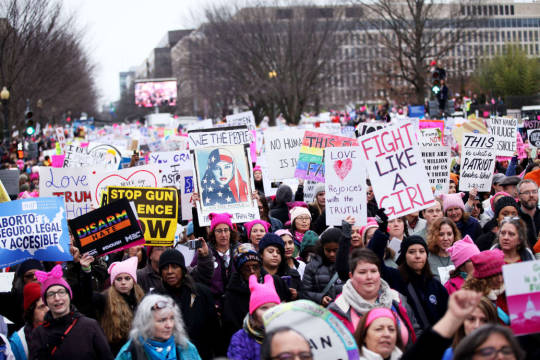
The Guardian-
Welcome to the fourth wave of feminism. This movement follows the first-wave campaign for votes for women, which reached its height 100 years ago, the second wave women's liberation movement that blazed through the 1970s and 80s, and the third wave declared by Rebecca Walker, Alice Walker's daughter, and others, in the early 1990s. That shift from second to third wave took many important forms, but often felt broadly generational, with women defining their work as distinct from their mothers'. What's happening now feels like something new again. It's defined by technology: tools that are allowing women to build a strong, popular, reactive movement online.
The majority of activists I speak to define themselves as intersectional feminists – or say they try to live up to this decription – and when I mention this to Kimberlé Crenshaw, the US law professor who coined the term intersectionality in 1989, she's genuinely surprised. The theory concerns the way multiple oppressions intersect, and although, as Crenshaw says, it can be interpreted in a wild variety of ways, today's feminists generally seem to see it as an attempt to elevate and make space for the voices and issues of those who are marginalised, and a framework for recognising how class, race, age, ability, sexuality, gender and other issues combine to affect women's experience of discrimination. Younis considers intersectionality the overriding principle for today's feminists, and Ali says she constantly tries to check her privilege, to recognise how hierarchies of power are constructed.
(https://www.theguardian.com/world/2013/dec/10/fourth-wave-feminism-rebel-women)
Britannica -
Although debated by some, many claim that a fourth wave of feminism began about 2012, with a focus on sexual harassment, body shaming, and rape culture, among other issues. A key component was the use of social media to highlight and address these concerns. The new wave arose amid a number of high-profile incidents. In December 2012 a young woman was brutally gang-raped in India and subsequently died, sparking local protests and international outrage. That was followed two years later by the Gamergate campaign, a manifestation of the so-called “men’s rights movement” that had its origins on the Web site 4chan. GamerGate ostensibly sought to promote ethics in video-game journalism, but it was in reality a harassment campaign against “social justice warriors.” The latter were often women who objected to female stereotypes in video games and were subsequently inundated with death threats and rape threats.
Against this background came Donald Trump’s defeat of Hillary Clinton in the U.S. presidential election in 2016. Trump had made a number of inflammatory remarks about women, and the day after the election a grandmother went on Facebook to propose a march on Washington, D.C. The suggestion quickly gained traction and became a call for social change, especially in regard to gender equality. Known as the Women’s March, it grew to include demonstrations across the United States and around the world. The protests took place on January 21, 2017, the day after Trump’s inauguration, and as many as 4.6 million people attended the various events in the United States, making the Women’s March perhaps the largest single-day demonstration in that country’s history.
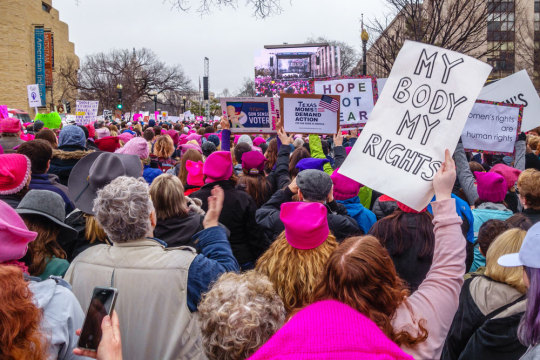
Arguably even more significant was the Me Too movement, which was launched in 2006 in the United States to assist survivors of sexual violence, especially females of colour. The campaign gained widespread attention beginning in 2017, after it was revealed that film mogul Harvey Weinstein had for years sexually harassed and assaulted women in the industry with impunity. Victims of sexual harassment or assault around the world—and of all ethnicities—began sharing their experiences on social media, using the hashtag #MeToo. The movement grew over the coming months to bring condemnation to dozens of powerful men in politics, business, entertainment, and the news media.
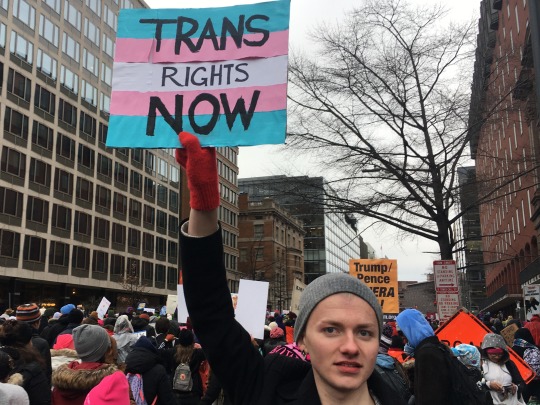
11 notes
·
View notes
Text
week 8- 10/14
1. What significance does a socially constructed female personae carry in a heteronormative paradigm?
Like Kate O’Riordan mentioned in her article, Gender, Technology, and Visual Cyberculture, many of the online personae are clearly constructed through a heteronormative lens. The image of a female personae is described as one with excess breast and lack of penis. There is also accentuation of the figure that can be described as small torsos and very little coverage from clothes (O’Riordan, pg.6). One of the many implications this carries is that the female simulation serves as a tool for men. The male gaze is prevalent when computer coding these personae. Female personae are being created in hypersexualized ways and are constantly being described as “babes” or “chicks.” The concept of female and femininity is socially constructed which fits the reality aesthetics of heteronormativity but places boundaries for non-cis woman. “At the point of production these figures thus close off understandings of what it means to signify as female, reinforcing visual encodings of hyper femininity as the definition of “female” (O’Riordan, pg.9). Another implication of the female personae is in relation to the cyborg. Simulations being “female” contradict the concept of a post-gender cyborg by Haraway, especially if the reasoning behind making it female is to rid anxieties of hyperintelligence because that associates attributes like friendliness to be strictly feminine and female. Ultimately placing women in a controlled environment in a male dominated field and as a tool for the male gaze.
2. How does Haraways concept of the cyborg rebut the reasoning behind the femininity of the female personae in O’Riordan article?
O’Riordan’s article discussed that the reasoning behind computer coded feminine personae was to rid of anxieties behind a hyperintelligent cyborg. Haraway however claims that “we can be responsible for machines; they do not dominate or threaten us. We are responsible for boundaries; we are they” (pg. 4). Now, Haraways essentially believes that we take part in the dualism that we are part machine ourselves, or chimeras. The difference in the idea that Haraway offers, is that cyborgs can exist in a post gendered society, ridding the idea of a female personae or simulation. Like Haraway mentioned, “gender, race, or class consciousness is an achievement forced on us by the terrible historical experience of the contradictory social realities of patriarchy, colonialism, and capitalism” (pg. 3). Therefore, femininity or the idea of it, does not solely belong to “womanhood.”
3. How do white women assert their role in the male dominated world of white supremacy?
While white supremacy has been highly dominated by men in the print- only era, white women have found their place in the online era of white supremacy. This breakthrough only creates room for more racist expressions in the online world. Daniels gives the example the ladies-only board at the Stormfront website. Due to the fact that in mixed-gendered forums, a woman’s voice is most likely to be lost in the pool of male dominated opinions, women took it upon themselves to create a space where they can express their voices. The emergence of ladies-only forums being created, since men still do not fully value a woman’s opinion even if they value the same white nationalist agenda, influenced the influx of online racist rhetoric. White woman who partake in these racist ladies-only forums can give their take on feminism and different feminist agendas like abortion where they clearly undervalue lives of people of color. Ultimately, these white women who have created spaces to express their racist opinions still blindly live in a heteronormative power dynamic in which woman are traditionally powerless. Daniels gives examples of women who write onto these forums in where they were in powerless positions like the user suepeace who felt that by retelling her stories of revenge essentially regained her power in her heterosexual relationship. In the end, white women have asserted themselves in the online era of white supremacy because they were overshadowed in the print only era and in mix gendered online-era forums.
4. How does white supremacy control sexuality online?
Controlling sexuality is a key feature in white supremacy and the danger of stepping outside the boundaries of heteronormativity can be grave. Perhaps the idea of white nationalism and eugenics have contributed to the idea of 1) intercourse between whites and non-whites, and 2) the idea of homosexuality. Daniels discusses the many example of white supremacy controlling the idea of sexuality, especially heterosexual ideologies. White supremist have created the idea of homosexuality being correlated with race, such as homosexuality being linked to Jewish communities. White supremacists have gone as far as emasculating their “own” white men for their “willingness to be penetrated” (Daniels, pg 16). The idea that interracial intercourse as well as homosexuality being not “ideal” because it does not produce white babies further supports the idea of white nationalism. It is interesting to see through the lens of white supremacists, both men and woman, and how strongly the domination of white men in print- only and online era affect the thinking of not only other men, but woman and young girls as well.
Daniels, J. (2009). Gender, White Supremacy, and the Internet. Cyber Racism: White Supremacy Online and the New Attack on Civil Rights (pp. 61-86). Rowman & Littlefield.
Haraway, D. (1991). A Cyborg Manifesto: Science, Technology, and Socialist-Feminism in the Late Twentieth Century. Simians, Cyborgs, and Women: The Reinvention of Nature (pp. 149-181). Routledge.
O’Riordan, K. (2006). Gender, Technology, and Visual Cyberculture. Critical Cyberculture Studies (pp. 243-252). New York University
10 notes
·
View notes
Note
hey! could you explain some of the history behind the stud identity?
stud is a black lesbian identity, much like AG (aggressive). though it is similar to butch in describing female masculinity, and stud/fem often mirrors butch/femme roles — it illustrates their unique relationship to womanhood by recognizing the specific ways in which they are subjected to, and impacted by, racism, homophobia, and misogyny due to historical constructions of black gender roles and perceptions of black female masculinity.
some historical information and excerpts about the meaning and evolution of stud identity:
in 1965, ethel sawyer conducted “a study of a public lesbian community” in st. louis, missouri. this was the earliest known sociological study of a black lesbian community anywhere in the united states. in this fieldwork, sawyer found that masculine black lesbians in the midwest referred to themselves as studs.
anita cornwell writes “the butch, who in all black gay circles that i have ever encountered is labeled ‘stud’” (from “a black lesbian is a woman is a woman…”, published in the los angeles free press, november 1972)
lorraine bethel references “the black bulldyke stud” in her poem “what chou mean we, white girl? or: the cullud lesbian feminist declaration of independence (dedicated to the proposition that all women are equal, i.e. identical/ly oppressed)”. (published in bethel & smith, 1979)
susan, in an interview about female prisoners, uses the term “stud broad” to explain “women who from physical appearance might easily be mistaken for men … contrary to the images in homophobic research and media … they are often unusually quiet and gentle … [she] sometimes won’t allow herself to be touched.” (from “sex is always the headliner”, published in sinister wisdom no. 16, 1981)
oshen t. explains “i identify as stud but, growing up, i didn’t know that there was a word, ‘stud.’ what was more common was butch, but at some point, like in my mid to late teens, i noticed that butches were usually white women, and even though i did see some black butches … at some point it got really irritating and didn’t fit me. i don’t feel butch, and i don’t like that word, even saying it. stud came out of me and my peers having a conversation, and i held onto that word stud. we younger studs from east oakland started to gravitate toward that. butch was white and older, and as young kids, we were studs. there was some age stuff, race and class. all the books were about stone cold butches … just white people. we were like, nah, that’s not us.“ (quoted in “masculine of centre, seeks her refined femme” by b. cole, published in persistence: all ways butch and femme, 2011)
b. cole writes “unlike white female masculinity, female masculinity for womyn of colour is based on sites of power and systemic oppression — through masculinities of colour. the assumption that they can be resignified with equal subversive and revolutionary actions against white manhood is false. the ability to access masculinity pivots upon the ways in which gender intersects with race, and these gaps have been filled with new ways of naming ourselves. in the last decade, the explosion of young masculine-of-centre womyn has created a demographic shift on the butch landscape, giving way to terms like ‘stud’, ‘boi’, ‘tom’, and ‘macha’ in california and the south, ‘dom’ within the d.c., maryland and virginia region, and ‘aggressive’ or ‘AGs’ in new york.these identities represent a redefined female masculinity that is rooted in the experiences of womyn of color and is more genderqueer than historical interpretations of butch……the emergence of this new language would not have happened were it not for the ways in which masculine-of-centre womyn of colour live their female masculinity through the lens of race. our identity has socially transformative powers and there are still nuances to our identities — masculine-of-centre mothering, social mobility, and historical racial oppression — which shape masculinity in ways that have yet to be fully explored…*womyn here is used to reflect that, for many of us, as masculine of centre, our gendered identity is not accurately reflected in the term women.” (reprinted in outside the XY: black and brown queer masculinity, 2016)
nneka onuorah said “black women don’t have a voice — black ‘AG’ [aggressive] lesbians don’t have a voice. i wanted to tell a story of my own for people who look like me.” (from an interview with NBC news about her film the same difference, 2015)
some films of interest:
the aggressives, directed by daniel peddle, 2005
pariah, directed by dee rees, 2011 (netflix)
stud life, directed by campbell x, 2012 (amazon)
the same difference: gender roles in the black lesbian community, directed by nneka onuorah, 2015 (kanopy)
7K notes
·
View notes
Text
Soooo I'm gna get mauled here but tumblr's unquestioning praise of Killing Eve as a progressive, prestige show about womanhood and sexuality is... looking like a problem to me.
This is not to shame people who watch the show or even to guilt people out of enjoying it, especially seeing as I've done both, (unabashedly admiring Phoebe Waller Bridge's distinctly quirky humour and Fiona Shaw's deliveries). This is to say, though, that the Killing Eve franchise is something to think more critically about before we give it more praise, more money. We can be critical of media we like, not limit activism to media criticism and not feel that media criticism in some way robs us of something. In my opinion.
[tw for discussions on sex, rape, pedophilia, violence, death, q slur]
[[more]] <---more --!>
Firstly the generation-wide age gap: Eve's original portrayal in the book is 24, exactly two years Villanelle's senior so the only logical excuse for it be added in the adaptation was bc the crew were desperate for big name actors. And while I love Sandra Oh, it was not worth it to create bizarre sexual tension between a forty year old and a twenty year old. This isn't even the first time Jodie Comer was the on-screen love interest to a middle aged person (see also Dr Foster), which is doubly messed up. Ideally replace Oh with an actor Comer's peer or replace Comer w someone Oh's age. It's not that hard.
Second, the age gap is exasperated by Villanelle's "mental age" which is far below twenty. Honestly the fact that both these problems were added into the adaptation by female actor/writer Phoebe Waller-Bridge makes me wna scream. Book!Villanelle was appropriately mature enough—emotionally, psychologically, intellectually—to warrant her high-ranking status as an assassin. Her behaviour, while still devoid of empathy, manages to be a believable portrayal of an upper-class 20 yr o behaving like a thirty year-old. Phoebe Waller-Bridge (and co)'s reinterpretation has Villanelle being a hyperfeminine, materialist, petty teenager that slowly spirals into impulsive outbursts and a scene where she's crawling around a suburb in a onesie. How do we reconcile Villanelle's lust and her love of violence with this childish persona? How is Eve's attraction to her justified? How do ppl think that's hot? It's comedic shock value flirting with homophobia, pedophilia, and the Born Sexy Yesterday trope. Not to mention the violent little girl trope. Despite all of Luke Jennings' flaws, he at least did not do That and my God is the bar low.
Both book and show heavily overplay Villanelle's sexual promiscuity to the point of being voyeuristic. Villanelle's sociopathy is largely an excuse for her violence, sex life, and lack of empathy to be over-the-top, even comedic, especially in the show adaptation. Villanelle's only true human connection is her infatuation with her language teacher, Anna. Which, rather than explore the show's pedophilic undertones, only serves to justify it via backstory.
The show does handle this way worse though: through Anna's dialogue, we're assured that the attraction was mutual ("She seduced me.") and that they've had sex. Which at the time would be when Oxana (Oksana) was in her late teens as she was still a high school student under Anna's tutelage. In the show, Villanelle murders Anna's husband partially out of revenge and possibly bc she took Anna's joke too literally. Book!Villanelle meanwhile castrates Anna's rapist. The former attempts to draw parallels between Eve and Anna, Nico and Anna's husband, treating the story like a melodramatic Shakespearean love triangle while once more reminding us of Villanelle's immature social skills. Which, again, serves to justify age gap lust. Meanwhile, the book attempts to question Villanelle's warped attempts at human connection via vignettes of violent shock value, it's marginally better than the adaptation but in the overall scheme of things I'm not sure Jennings makes enough commentary on violence against women to warrant this.
Finally sexuality in the franchise is a big question mark. Eve and Villanelle's attraction to each other is explained simply by obsession and lust intermingled with violence. Villanelle and Anna's relationship devolves into much the same in the show. Eve and Nico have a relatively stable yet dispassionate relationship meanwhile Bill is implied to be bisexual with an open marriage, though this is never seen and he's murdered shortly after this confession. A Chinese politician has a hospital fetish and, in the book, a right-wing fascist has a kin/kink for Eva Braun which leads us to a highly disturbing transphobic scene involving an exploding dildo. Notably, Villanelle's on/off frenemy romance with Lara (who is... you know... her age) in the book is cut and replaced Nadia, whom she basically kills as soon as possible.
The relationship between Oxana and Lara is explored more in the book (and it's post-season 1 sequel) though ultimately, Lara dies and Villanelle can't feel remorse let alone love. Both book and show have Villanelle hooking up with various people but the book goes into painstaking detail about her sexual promiscuity being motivated by her desire to manipulate peole. Clearly, Jennings shows that Villanelle's sex life includes all genders yet with little regard for her intimacy and level of attraction for anyone. She is "bisexual" (or "lesbian") only insofar as actual physical sex is concerned. Emotionally, she is attracted to no one. Which let me just say is a capital y Yikes.
And the cherry on top of course is that the show is getting accused of queerbating due to the heavy marketing a nd WLW undertones despite Sandra Oh's denial of any romance btwn her and Jodie Comer's character. 🙄
All of these play heavily into existing homophobic stereotypes. The predatory lesbian. The hypersexual bisexual. The manipulative, hedonistic, childish, lustful qu**rs, who, having foresaken family values to screw anything and everything, are not emotionally mature enough to be first class citizens. From watching the show and reading the book, the writers play with these "dark" themes with little introspection to how these relate historically to LGBT politics, how their use of sociopathy and age gaps has political and sociological significance. There's little real deconstruction or reflection on gender, sexuality, violence etc to be considered satirical and these aspects are largely thrown in for entertainment's sake.
Jennings and Waller-Bridge have both, respectively, made attempts at thematic critiques of wealth and gender. Neither of which in my opinion saw its theme through enough to be satirical. There's something to be said about how PWB converted Jennings' anti-materialist subtext into "empowering" aspects of literally weaponised feminity (i.e. all of Villanelle's weapons are high-end women's products) almost as a critique of cultural dismissal of femininity and it's association with materialism. PWB seemed to want to create a comedic, empoweringly gendered, spy movie but this theme of weaponised femininity nose dives at Villanelle's immaturity not to mention its superficiality. Weaponised femininity directed at whom? The show seems much more fascinated with Villanelle herself than the fact that she's employed by The Twelve, which obscures the importance of who Villanelle is killing, who Villanelle exerts weaponised feminity against and why. Not to mention the concept of the feral, empowered or weaponised woman has always been positively attributed to white women, which to make a long story short is not new or progressive or empowering.
I'm not too puritanical to understand the use of taboo themes in satire. This is not satire. KE's appeal seems to be the sexualisation of its deuteragonists at the expense of nuanced conversations about sex, violence, and gender. PWB was way more fixated on comedy than I think she should have been, and both creators rely most on shock value than anything else in how they construct what they believe be the most entertaining and well-structured narrative. There's little evidence that they regard the responsibility they have in portraying bisexual women in positions of power, in age gap relationships or as violent characters in a political espionage thriller. This is not satire this is a very eclectic comedy with clumsy homophobic caricatures at best.
Lastly, there are essays on why leftist fixation on "representation" is a symptom of our digital hyperreality and at best will never truly address material problems faced by real people. Big ass metas on tumblr is not necessarily activism and as I'm sure you know the revolution will not be televised. But should show runners and co be rewarded for so called groundbreaking dark comedy that in fact seems to support harmful stereotypes? And goddamnit am I tired of people unironically romanticising Villanelle and Eve. Thank you for listening to my TEDtalk.
20 notes
·
View notes
Text
Engel and “Nice White Lady” Racism
“The most effective adaptation of racism over time,” DiAngelo claims, “is the idea that racism is conscious bias held by mean people.” This “good/bad binary,” positing a world of evil racists and compassionate non-racists, is itself a racist construct, eliding systemic injustice and imbuing racism with such shattering moral meaning that white people, especially progressives, cannot bear to face their collusion in it.
- A Sociologist Examines the “White Fragility” That Prevents White Americans from Confronting Racism [X]
I’ll be the first to admit: I like Engel. She’s quickly become my favorite Vilde for a number of reasons. She seems kinder, more open to admitting her mistakes, and more aware of her own discomfort. Above all, she’s not openly hostile to Imaan and it seems like she’s really trying to make Imaan feel included. It seems like a lot of the fandom agrees.
Something that the fandom also seems to agree on is how rude Imaan is. “Why is she so mean?” is a question, in many different forms, that keeps popping up. And the consensus behind this seems to be that her actions and words are mostly unwarranted. Ad that’s because Engel is sweet and kind and even when she messes up, she apologizes. So it’s not like with Kiki (Druck) or even Vilde (og Skam). In short... a lot of folks seem to agree that Imaan is being mean for no reason.
But I think it’s important that we investigate this a little further.
Because to Imaan... it probably doesn’t seem like “no reason.” And to me, and maybe some other Muslim fans and/or fans of color watching, it doesn’t feel like no reason at all. In fact, much of it seems warranted. And what really feels mean is that I can’t seem to escape the same old defenses of white women/white womanhood that have oppressed WoC for centuries. I'm tired of being forced to see things from white women’s point of view. And I’m tired of WoC being condemned for their anger.
Because regardless of how sweet or well-intentioned Engel seems to be, what she’s doing is still rooted in racism and Islamophobia.
Let’s move back for a moment, though. Because this is not only an issue of racism and Islamophobia, but of sexism and patriarchy, particularly when it comes to white women.
As the quote says above, there's this widely perpetuated myth that oppression on an interpersonal level is always openly ad intentionally hostile, mean, or aggressive action or words. But the truth of the matter is, someone behaving in a racist or Islamophobic way also includes microaggressions. Even if there's no intention of malice behind microaggressive actions or words, they still cause harm; they continue to support and perpetuate racism. They continue to negatively affect the People of Color they're directed at, even if the person doing/saying something doesn't think it will. The important thing to remember is that impact is more important than intention.
But we’re not taught this about oppression. We’re taught that racism and Islamophobia is intentional violence - most of which is wrapped up in white manhood. Despite the fact that white women have historically been just as intentionally violent in their racism as men, it’s easy to continue to think of white women as non-perpetrators. On a globalized scale, we're taught that white womanhood is something that needs to be protected. That, especially young white women, are fragile or just don't mean harm.
And yes - while this idea of needing to protect white womanhood was created and is perpetuated by patriarchy, it doesn't mean that white women don't benefit from this. Under this patriarchal assumption that white women are always victims needing protection, People of Color (in particular, Black women) are seen as inherently aggressive, hostile, and dangerous. (For those who’ve seen Get Out, one example: white people kept defending Rose after they saw the film. Rose. The catalyst for so many Black people dying.) White women are constantly given the benefit of the doubt.
Of course, Engel isn’t killing people. Hell, she’s not even intentionally discriminatory, (it seems). But that’s part of the issue here. Because Engel is so nice, it’s so easy to feel sorry for her - and so easy to condemn Imaan for her reactions.
Now, separately, each of Engel’s racist and Islamophobic microaggressions don't seem so bad - but put them all together and it's clear to see why Imaan is frustrated. Especially because we can assume that Engel is not the first, nor will she be the last, to say racist things to Imaan. Imaan has probably had to deal with people assuming things about her and her communities simply based off of her race and religion her entire life - and has probably had to deal with worse things than constantly hearing people randomly ask "don't you get hot in that thing?" Because even if Engel is well-intentioned, white nationalism is on the rise not only globally but in the Netherlands. To not take that into account - even as an unwritten backstory - to why Imaan reacts the way she does even to casually racist remarks is, I feel, a huge misstep.
If we start to break down some of these scenes - but instead of focusing on Engel’s reactions and feelings,we re-center Imaan in these analyses - then a pattern emerges. We see Engel constantly Othering Imaan and Imaan constantly feeling upset by Engel’s words and actions.
1) Engel Is Clearing Uncomfortable Meeting Imaan
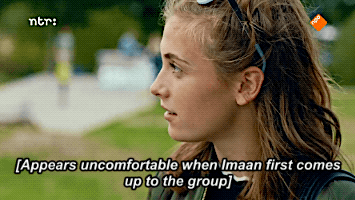
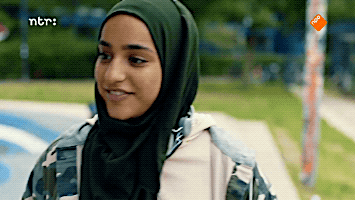
When Imaan first comes up to the group, Engel looks physically uncomfortable and confused. Even though she knows nothing about her, has not even known she existed before this scene. But she’s automatically made a judgement about Imaan. Consciously or not, her emotions are written all over her face.
Now, check out Imaan’s reaction. When she introduces herself she’s smiling, she looks excited. That is, until she notices Engel’s face. She even does a double-take. The smile falls off of her face; it’s like she’s gotten this reaction before and she’s already gearing herself up for some racist or Islamophobic remark.
2) Engel Makes A Snap Judgement About Imaan
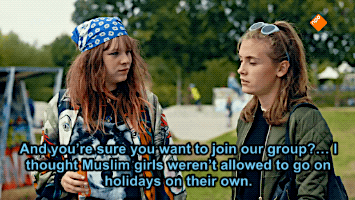
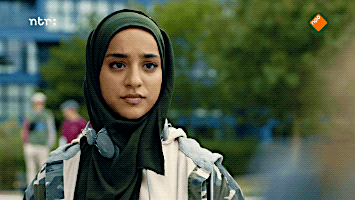
It looks like Imaan was right to gear herself up. Because immediately, Engel questions Imaan. Now, in Engel’s POV, this maybe looks like something sweet. A tentative ask, based off of the things she’s heard about Muslims.
But look at Imaan’s reaction before she makes her sarcastic comment. She looks hurt. She looks angry. She looks like she can’t fucking believe what this white girl just said to her, spouting off some stereotype that feels like it’s tied up in assumptions about Islam being sexist. Because here’s the thing: how is Imaan supposed to know exactly what Engel means by this statement?
As the audience, it’s easy to assume Engel means no harm. But how do we actually know that? We know nothing about her besides our socialization of innocent white womanhood. But as most PoC can tell you - white women are just as dangerous as white men are. And at this point, we - and Imaan - know nothing about Engel. None of us know if this was an intentional jab or simply trying to be polite or what.
3) Engel Is Clearly Uncomfortable About Imaan Being In Their Group
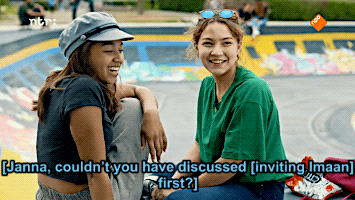
Now this is a small detail but it’s important: Engel specifically asks about Imaan joining the group after she and Janna walk away. As they go, it seems like they’re arguing a bit. We can’t know for sure, because this is Isa’s POV and they’re walking away. But there are a lot of implications behind this, including the one that Engel doesn’t feel comfortable about Imaan despite not knowing anything about her but her religion and her race. This small bit reinforces the idea that there’s something about Imaan that has Engel on edge. And as educated viewers, we should already know what it is.
4) Engel Continues to Make Assumptions About Imaan Based Off Of Her Race and Religion
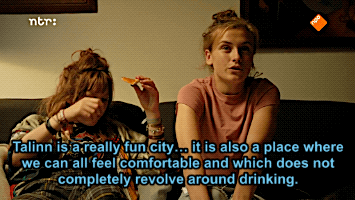
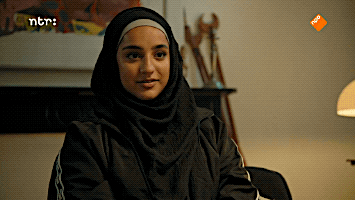
Engel explains that she chooses Talinn for the city trip because it’s a fun place that doesn’t revolve around parties. It’s clear in this scene that she’s pointedly talking to Imaan about that. And on the surface, this actually feels really sweet - she’s trying to be inclusive, trying to be understanding of restrictions (she assumes) Imaan has, being a Muslim. She’s being nice.
But again, let’s focus on Imaan’s reaction. She doesn’t look particularly pleased or grateful - in fact she seems mostly just confused. And as the video pans to Isa and Liv and an awkward silence ensues, I think it’s clear they feel the same as Engel. Something that might have been done in an effort to be respectful just seems to fall flat. Because it’s again based on assumptions, not based on anything that Engel actually knows about Imaan. She’s singling her out.
5) Out Of No Where, Engel Asks A Personal Question About Hijab
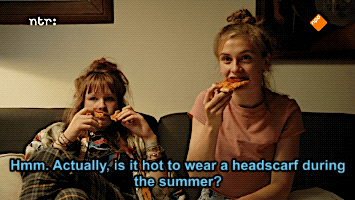
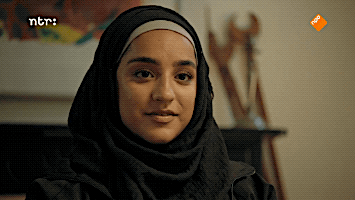
Seriously, this question... comes out of nowhere. It has nothing to do with what they’re talking about and it makes no sense to bring up. Imaan does seem to have a positive reaction to this though - after Engel compliments how pretty she looks, a small smile creeps onto her face. She seems pleasantly surprised that that was the follow-up to the original question. And I think with that small addition, it’s safe to infer this isn’t the first time she’s heard this - she already has the snappy “it’s hot in the summer anyway” response immediately. She’s used to people commenting on her hijab, and probably with her about it.
It’s honestly, probably what Imaan’s expecting, especially after the initial introduction. Because she can only base her responses on what she’s previously experienced with other white people - and she can only make assumptions based on those experiences. At least, until Engel surprises her. And Imaan seems genuinely okay with Engel’s response to her response, which is good. But it doesn’t stop the original question from bizarre in the context of their conversation.
Something that we should be asking is why it was important for Engel to ask that, in that moment? Why was it necessary for her to question Imaan about her hijab?
6) Engel Tries To Be Culturally Sensitive While Othering Imaan
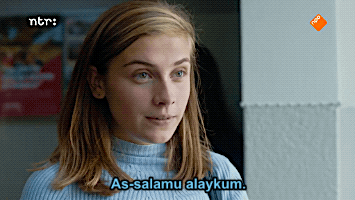
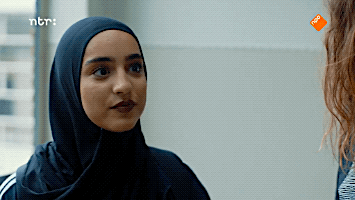
This scene, I feel really brings together the drive behind Engel’s Nice White Lady racism, and that’s the idea that she doesn’t really see Imaan as belonging. Again, this is something that seems nice, right? Engel made the effort to learn an Arabic, Muslim greeting to include Imaan. To make her feel welcome.
But look at Imaan’s response. She again just looks confused, and maybe a little amused, as she says “okay.” Because it’s actually very weird to speak to someone in a language that you have never heard them speak. It’s random and it’s weird, especially considering not once before this has Imaan spoken anything other than Dutch to Engel. Not once has she used an Arabic greeting or asked the others to do so.
7) Engel Openly Admits She Doesn’t Think Imaan is ‘Really’ Dutch
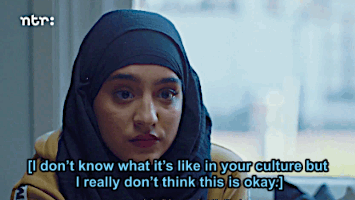
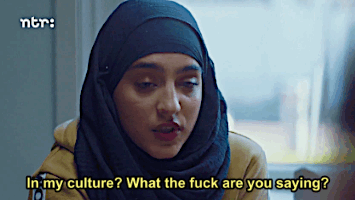
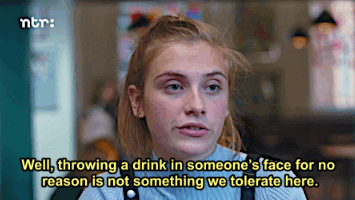
I think this scene is so powerful because it’s the culmination of the rest of Engel’s Nice White Lady racism. Because this is the root of the matter, isn’t it? Because although this isn’t even said cruelly, it’s said plainly. And it addresses all of Engel’s microagressions against Imaan thus far.
It’s the idea that Imaan isn’t one of us. Imaan doesn’t understand our culture. Imaan doesn’t belong here.
Imaan is an Other.
Engel's racism has been very subtle in that it continues to perpetuate the idea of Imaan as Other - as someone who, because of her race and religion, isn't really Dutch and isn't like Engel and the other girls.
Acknowledging that someone is going to have different customs, traditions, or belief systems because of their religious and ethnoracial background is important, of course! But in cases like this, it's a form of homogenization. It's indicating off the bat that Imaan - as a brown, Muslim woman - doesn't belong and make a lot of assumptions.
As we see in these scenes, it very well might feel like Engel really is "just curious" and attempting to be inclusive. I think there's an intention, on behalf of the writing staff, to give her a sort of ignorantly innocent air (as opposed to some of the open hostility we've seen from other Vildes). And Engel even admits it herself - she’s not trying to hurt Imaan.
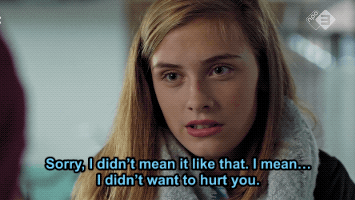
But I don’t think we should be lulled into seeing things only from the white woman's side. I've seen too many posts thus far that aren't even attempting to view things from Imaan's point of view. And if folks did try that, I think it would be much more obvious why she seems "so rude" in the face of Engel's microaggressions. Because when we look at Imaan’s reactions, I think it’s clear that they do affect her negatively. And they’re just some of the many, many racist and Islamophobic things she experiences every day.
And that's really the root of the matter; and why, in og Skam (season 4), the bench scene with Isak and Sana was straight up bullshit. Because the burden should not have to continually fall on marginalized people to meet everyone else where they're at. This is not to say asking questions when appropriate and/or encouraged is wrong. We only learn about our differences when we make the effort to educate ourselves. But it should not be the burden of marginalized folks to continuously answer unprompted questions, to continuously be nice to people who assume we don't belong, to continuously be picked at and prodded and have to defend ourselves.
And I'm tired of Good White People lecturing People of Color about how we should be nice and patient when the same kind of respect isn't given to us. Our lives are not after-school specials for white people to learn from. We are constantly asked to meet white people where they’re at - but white people rarely do any work to confront their own racial identities. They are rarely asked to think about how we are affected by their curiosity.
As far as Imaan knows, Engel is at best “ignorant but open” and at worse blatantly hostile. But regardless of which one it is, it makes me extremely uncomfortable to police how WoC react to the racism they experience, intentional or not, in order to defend white people. And I'm seriously hoping that of all the remakes, Skamnl is the one that addresses this. Because it's extremely fucked up to continue to ask WoC to cater to the emotions of white people, namely white women, because they're "trying." It's gross to ask us to put aside our right to be wary, our right to be annoyed, our right to be angry when faced with racism just because "you know she's just trying her best, right?"
I think the best comparison to this scene in the Skamiverses was in Druck, in the first scene that we meet Amira. The theater kids don't give her the flyer to help tutor refugee students because they take one look at her and assume that she's not German. That she's also a refugee, that she doesn't actually belong. And as good-intentioned as they may have been, their assumptions were still racist and Islamophobic. They were still stereotyping Amira based off of how she looked and without even speaking to her, already labeled her as Other.
And just like that was important to show - as was Amira and Hanna's reactions, confirming for the audience that this microaggression is occurring - I think it's important to also show Engel's brand of Nice White Lady racism. Because racism isn't always consciously done, it isn't always a physically violent act. But what Engel is saying is violence. And it is messed up. And it's a kind of racism that People of Color are constantly dealing with, especially from "allies" who think what they're doing is inclusive - when really all it's doing is perpetuating the idea that we are Other.
I'm glad that across the Skamiverse, the showrunners are showing different forms of racism in the Vildes. I really applaud Skamnl for taking the risk to show this sort of Nice White Lady racism and the subtle ways in which it has been affecting Imaan. But I also really hope that by the end of S1, Engel explicitly apologies for her actions. I also really hope that as viewers, some of the fandom isn’t so quick to continue to condemn Imaan and coddle Engel.
- mod Jennifer (11/1/2018)
71 notes
·
View notes
Note
(1) Hi, I’m not asking this question to offend anyone, this is a genuine question I have. If I offend anyone for being insensitive I am very sorry. So I've been thinking a lot of the differences between transracial vs. transgender and the more research and opinions I find on it the more I get confused. The main argument against being transracial is that a transracial person hasn't gotten the full experience of the specific gender they are identifying due to them living as birth gender. continued
(2) Like Rachel Dolezal being told she is not allowed to identify as black because she hasn’t gotten the true experience of being a black woman in America due to her living the her life as a white woman. However, can’t the same thing be said, for example, a MTF transgender person? It is undeniable that there is a specific woman experience. And for people (especially who realize they are trans late) live their lives passing as a man and don’t get this experience. (continued)(3) Being a woman is being catcalled, is being objectified, and is being paid less than their male counterparts. A MTF trans person doesn’t experience those for most of their life until they begin to live their lives true to their real selves. Why does this ‘experience’ argument work to discount transracial but doesn’t discount transgender? Again I’m very sorry for this question, I will admit myself it is very ignorant. But I just really want an answer to this and I hope I can get that.Harper says:Hi there, I’m going to assume you are asking this in good faith but to be quite honest the phrasing of some of your questions seriously makes me doubt that. Before I start, I want to clarify as Kii does in this ask that transracial is a term that actually describes someone who has been adopted by someone to a family of a different race, rather than the racist stuff Dolezal is doing.First off I’m going to address some assumptions about being a woman that you make in your question: “there is a specific woman experience” and that that experience “is being catcalled, is being objectified, and is being paid less than their male counterparts.” It’s curious to me that you claim there is an “undeniable… specific woman experience” and then only cite moments that we can see other people who are not women experience. For example, homophobic catcalling, i.e. verbal sexual harassment can and does happen to effeminate gay men on the streets; black men are a site of sexual objectification in much of media, consider pornography for example; gay men, men of colour are also paid less than their male counterparts and have been for some time historically. If you base your understanding of what makes a woman entirely on something like misogyny, you have to be open to the fact that other oppressive forces will coalesce in the same way to recreate similar experiences in similar liberation groups. You should also acknowledge that gendered discrimination doesn’t operate on a basis purely targeting women. I think you should broaden your understanding on how such forces work. I recommend reading Julia Serano’s Whipping Girl:
While often different in practice, cissexism, transphobia, and homophobia are all rooted in oppositional sexism, which is the belief that female and male are rigid, mutually exclusive categories, each possessing a unique and non overlapping set of attributes, aptitudes, abilities, and desires. Oppositional sexists attempt to punish or dismiss those of us who fall outside of gender or sexual norms because our existence threatens the idea that women and men are “opposite” sexes. This explains why bisexuals, lesbians, gays, transsexuals, and other transgender people — who may experience their genders and sexualities in very different ways — are so often confused or lumped into the same category (i.e., queer) by society at large. Our natural inclinations to be attracted to the same sex, to identify as the other sex, and/or to express ourselves in ways typically associated with the other sex blur the boundaries required to maintain the male-centered gender hierarchy that exists in our culture today.In addition to the rigid, mutually exclusive gender categories established by oppositional sexism, the other requirement for maintaining a male-centered gender hierarchy is to enforce traditional sexism — the belief that maleness and masculinity are superior to femaleness and femininity. Traditional and oppositional sexism work hand in hand to ensure that those who are masculine have power over those who are feminine, and that only those born male will be seen as authentically masculine. For the purposes of this manifesto, the word misogyny will be used to describe this tendency to dismiss and deride femaleness and femininity.
I’d also like to turn your attention to Jacob Hale’s essay Are Lesbians Women? in which he lays out a list of factors of what makes a woman. He does so in such a way where each individual item on the list is not necessary nor sufficient in order to be a woman. For example, although he lists ‘presence of breasts’ as one such condition that is often correlated with being a woman, there are plenty of women without breasts in the world: trans women without breasts, cis women who have had double mastectomies, and so on. Hale also notes that his list is not entirely exhaustive: there’s always the possibility that this list will be added to in future. I’d highly recommend you look at it if you’re after your “undeniable” “woman’s experience”.Next I’m going to look at your claim that “an MTF trans person doesn’t experience those for most of their life.” This entirely constructs a similar narrative for trans women and entirely disregards the possibility that such a person was raised by understanding and supportive parents from a young age and grew up as a girl from an early age. Whatever your argument about ‘transracial’, it’s clear that you already have a reductive understanding of womanhood and a transgender experience. Such forces and experiences that play into gender interact in ways far more complex than what you’ve detailed above. I also want to point out here that you’ve failed to describe how the arguments above apply to trans men: that is to say a trans man who transitions in his late twenties in the western world will probably experience all of what you label as the “woman experience”, and yet they are men. The argument you present is typical of the considerations ‘transracial’ arguments operate with. They are often circulated by people with a vested transmisogynistic interest as a “gotcha!” designed to portray trans women as either dangerous or ridiculous. As a result they are designed to eliminate any shred of transgender voices. What is implicit in the argument you’ve laid out is that 1. trans women aren’t women and 2. trans men are. The argument fails completely to consider how a trans person articulates their own understandings which often run contrary to the line of argument. I urge you to consider how this argument is made and what purposes it serves. Is it an honest exploration of the workings of gender and race or is there a bias or a motive driving the ‘logic’ of the argument.On to the ‘transracial’ aspect of your argument. I hope so far I have managed to draw your attention to the implicit biases given in the argument, as well as the levels of complexities you have yet to acknowledge. Much of the same can be said about how you present race in the argument.First of all, I’d like to draw your attention that considerations of being perceived as a different race is a reality faced by many white-passing people of colour and many mixed-race people who live through this daily. It is a consideration that has been often articulated and is still often articulated. If the argument was an earnest exploration of the shifting and transitory nature of the perception of people of colour in a racist society, would it not rather look at this aspect? If the argument was an honest exploration of the similarities and differences a construction of both racialised and gendered experiences, would it not center trans women of colour’s voices as they are best situated at this intersection of race and gender to experience this? Is it not suspicious that such an argument doesn’t do this? In fact, go read Franchesca Ramsey’s article on this for a black trans woman talking about it, and Riley’s arcticle, a black non-binary person who highlights:
Rachel Dolezal flat out lied about her life and her experiences, and not to protect herself, but to protect the benefits she received and the space she acquired through those lies. She lied to protect her privilege, a trait of white people and all privileged groups. Her life could have been the same had she merely remained the white woman she was. White people already devour space in Black communities as a bonus of their whiteness, but she chose to take her farce further, becoming a “Black” woman who happened to be indistinguishable from the party in power.There is no benefit to being transgender, and there is no harm, but there is every benefit and harm to a white person picking a less privileged race to join because white features are privileged in every race and identification has no effect on that.
(my emphasis added.)In addition to the points raised by Riley and Ramsey, I’d point out that the move to make a blind comparison between race and gender on the basis of “they are both experienced by people” or “they are both social constructs” “so why can’t x” is just so materially and historically off. There is no consideration in your given argument over the differences between race and gender. There is no consideration that racism was founded by a white ruling colonial class to dominate a colonised and enslaved population. Such a population had within it differently gendered and transgendered people. There is no consideration that this domination was a product of hundreds of years of a capitalism that needed a large white working class to carry out a sustained colonial project: a colonial project that is still in action across the world today. There is no consideration of the formation of gender and the nuclear family as a product of the division of labour enforced by capitalism and the ruling classes on the working classes.In effect, gender and race are two different things. They of course intersect, but the ways in which they operate are distinct and different. Reducing both down to a level that strips them of their actual effects and lived realities in order to further either a justification for a racist white woman exploiting black people or to further a ridicule and strawmanning of the transgender community is a shameful act of bigotry posing under a guise of logic and inquiry.
Check out our /tagged/transracial for more commentary.
#Anonymous#harper says#transracial#racism#transmisogyny#transphobia#hale#serano#caps#im not going to tag this mtf because it'll just be noise in that tag#misogyny#mtf /
89 notes
·
View notes
Note
Biological sex is not arbitrary and a matter of personal identity. Intersex people are male or female. There is no third sex. You just sound ignorant and how it's not a matter of our disorders confusing you but your intention to reject us. If we have a uterus, we're female. It's the female reproductive organ. You should educate yourself instead of clinging to 5th grade biology and whatever mutuals said about intersex people which made you deny our sex. And I know you're a self hating white woman and all, but try to not reduce womanhood to femininity. That's the social construct, not our sex.
Intersex is a recognized biological sex, please stop sticking to your narrow-minded and conservative, 5th year biology knowledge. You rather show yourself to be very ignorant yourself with this ask...
Sex and gender are arbitrary concepts, which means certain characteristics were randomly assigned to these random categories ages and ages past and they are culturally and socially, also historically dependent and therefore not universally, 100%, all-time reliable and natural concepts, but in fact made up due to wanting to depict a morsel of the visible reality in language. Look up how arbitrariness of language works. Interesting stuff.
So, I see, you define "woman" and "female" by the fact whether a person has a uterus? Alright, then what about my mum? She's a woman but doesn't have a uterus because it has been removed. Is she not a woman anymore? Alright... Then what about women that don't have a uterus because they just weren't born with one but they may still have ovaries or also the other way around? No women? Mm.. they might disagree...
Also are you really telling me you reduce "women" and being "female" to an organ being used to be able to have children? Isn't that objectifying women? Isn't that misogynistic because you only see those as women that could potentially have a baby? But some women may not want to be defined by their fertility or by being able to reproduce? What about them?
Reducing womanhood to feminity? Terfs do this. They are very eager about promoting these narrow concepts of what feminity and womanhood are supposed to be like...
I don't think in terms of feminity or womanhood though, as I'm non-binary. I just look at stuff and lable it "feminine-coded" or "male-coded" or typically assigned to womanhood or manhood because that is how it is. Society and media have assigned certain traits, styles, appearances characteristics to "feminity" or "masculinity" when in fact these traits etc are all shared among humans and shouldn't be restricted by these categories. That's why we have all these issues with girls being labeled tomboys just because they may dress or act more "masculine" or boys being laughed at for wearing skirts or make-up... "femininity" and "womanhood" should not be rigid categories enforcing outdated gendernorms... They should be open, fluid concepts allowing for deviation or open hollows at the fringes.
It's all a social construct - both womanhood and feminity - by the way.
0 notes
Text
You did a whole lot of talking around my argument and not a whole lot of engaging with my actual issue with your ridiculous ideology.
1. Sex and gender are two different things.
Gender is not based on sex because we have xx people with natural ovaries and a penis that get socialized as men. Why? Because society has already decided that men=secondary sex characteristics and women=secondary sex characteristics. This means a penis=man, a woman=vagina.
This doesn't mean there is a "biological" reason women are oppressed. Only that bigots use pseudoscience to justify their bigotry. Because before we learned that xx=female in biology, we were still oppressing women based on how they look.
It's the same thing as how race is not biological but it is a social construct that uses biological components as justification for bigotry. It's the same shit, different toilet. Because albino african individuals still identify as "black" even though they are not biological black.
2. Women get socialized as women and that is the reason for their oppression.
It still does not follow that their sex chromosomes are the reason why, because we were socialized as women before we even knew about genetics. It literally all just comes down to how you look. So therefore, and this is what terfs hate, if you pass as a trans woman, you WILL experience gender based bigotry.
3. "Who is doing the socializing?"
Society, bitch. Like, sure, did society look at our private parts and assign sex at birth to us? Yes, I'm not denying that. But to say that is because there is an "innate" womanhood and not just something that people chose to target for shits and giggles is a fucking stretch.
Because historically, intersex people were not being categorized as different sexes or genders. They were socialized as either men or women based on what their genitals looked like. But if you want to go there, then again we come back to xx intersex people with an ovary and a penis both at the same time? How do you classify these people under your gender ideology?
Are they men because of their secondary sex characteristics or are they women because of their xx chromosomes? You cannot answer this definitively with your narrow "women=xx" definition.
4. Stop using intersex people as a pawn.
No, reminding you that biology is not as binary as you claim it is is not using anyone as a pawn.
If your claim is that intersex people are rare, they are double the population of trans people (total, men and women) so they have more of a stake in this than trans people do, since they are way greater as a group than trans people are in population size.
Since terfs care alot about trans people who are less than 1% of the adult population, asking you how 2% of the adult population (intersex) fits into your "revolutionary" new gender ideology is very reasonable.
5. Terfs are radical feminists.
No, i use terf to mean trans exclusionary radical fascist, because that's what you guys are. Fascists. Radical means doing something that's never been done before.
Excluding trans people from their gender identity is a tale as old as colonization, and transphobia is actually a remanent of british colonization to be exact. So nothing new, radical or revolutionary in your ideology. Just the same old bullshit that's centuries old and only benefits the white patriarchy, but by all means, continue being a piece of shit.
Regardless of what you say to jerk yourself off at night and pretend like you're not a bigot, you are doing NOTHING new or radical. You are just a conservative fascist who wishes to maintain the status quo because it benefits you.
Terfs sound very stupid when they claim "I'm just talking about basic biology" sis, biology doesn't end at the 7th grade level. ADVANCED biology disagrees with you, you dumb cunt.
550 notes
·
View notes
Text
Bridgerton: Let’s Talk About Sex Education, Baby
https://ift.tt/3n6QZ6O
This Bridgerton article contains MAJOR spoilers for Season 1, including the ending.
If you think our sex education could be better today (which you should), then Bridgerton‘s depiction of Daphne’s pre-marital lack of knowledge around sex may astound you. In the first season of the delightful romance drama, Daphne has to find out about masturbation from Simon and heads into her wedding night knowing next to nothing about what might happen between two adults in lust, aside from the fact that it has something to do with the act of having children. Later, Simon keeps the details of his “inability” to have children from his new wife much longer than he could have if Daphne had a better understanding of procreation.
Elsewhere on the show, Penelope Featherington and Eloise Bridgerton put their considerable minds to the task of finding out how babies are made so they can avoid getting pregnant before marriage—a valid question and concern for women of any era. Unfortunately, the closest they get to answering it is: women get pregnant because of love, which is not very helpful. (Bet you’re feeling pretty lucky to have Google right about now.) Is this level of ignorance historically accurate? Let’s dive into the real history of sex education in Regency-era England to find out.
The first season of Bridgerton is set in early 19th century London, which falls during the Regency sub-period of the Georgian era. While many think of old-time England as a repressive place, that stereotype comes more from the Victorian era, which followed the Georgian era when Bridgerton is set, and was notoriously repressive when it came to matters of sexuality and “morality.” The Georgian era was (generally) less conservative. As historian Faramerz Dabhoiwala puts it in his book Origins of Sex: A History of the First Sexual Revolution (via The American Conservative), the 18th century urbanization of England (by 1800, more than one million people lived in London) led to “more opportunities for sexual adventure,” and an increase in pre-marital and extramarital sex. By 1800, almost 40% of brides getting married were already pregnant, and about 25% of first-born children were born out of wedlock.
“We know that Regency society is a very bawdy society, generally,” Bridgerton historical consultant Hannah Grieg told the Chicago Tribune. “Extramarital sex is no longer illegal, most adult consensual sex is within the law, there’s a very open culture of prostitution in London. We get celebrity courtesans and mistresses.”
That being said, just because society is free for some, doesn’t mean it is free for all. England circa 1813 had its own share of socially-constructed ignorances and, as with today, one’s access to sexual education varied based on things like gender, class, and location. In Bridgerton, this kind of difference is depicted in instances like Marina knowing much more about sex and pregnancy than Daphne does before marriage. Presumably, that is partially because she has already had an affair and become pregnant before she even comes to London, but it is also because her slightly lower class (and childhood on a family farm) has not meant the same degree of social shielding as Daphne. That said, Marina presumably had little education or knowledge about birth control and, as we see later in the season, does not have the necessary knowledge (or access to resources) to effectively terminate her pregnancy.
“There would have been nothing in the way of formal sex education,” Lesley A. Hall, a historian of gender and sexuality, told the Tribune. “Mothers might have given some premarital counsel to daughters, but although it almost certainly wasn’t actually ‘Close your eyes and think of England’ it may not have been much more illuminating.”
And, as with today, most freedoms in Georgian-era England benefitted the white, heterosexual, rich men first, most, and sometimes to the exclusion of all others. In Bridgerton, we see a stark difference between what is socially acceptable for Anthony vs. what is socially acceptable for Daphne. Anthony carries on a sexual affair with Sienna and, though he doesn’t particularly what his family to find out, it would not ruin him. For Daphne, however, merely being alone with a man who is not family could ruin not only her prospects, but the prospects of her sisters, as we see happens with the unmarried Bridgerton girls when Marina’s pre-marital pregnancy is made public.
Obviously, Bridgerton is not going for total historical accuracy. As with all period pieces, the story is as much if not more so about now than it is about the time in which it is set. Modern viewers are not watching Bridgerton for an education about the past (nor would they, on the whole, get one); they are watching it as a cathartic and escapist romp, which also has incredible social value.
So what does Bridgerton‘s treatment of sex have to say about today? That is up for interpretation, of course. For me, it is an exaggerated depiction of some of the struggles and joys of contemporary womanhood, in particular a denouncement of all of the decisions about our bodies and our futures that are still kept from us. Here (and in some more obvious ways), it is represented as various female characters’ ignorance around sex, a subject that is kept from them not only by the men in their lives but, in some cases, by other women upholding the patriarchal norms. Daphne herself realizes she has been one of these women when her own experiences lead her to see Marina in a new light. She finds empathy for Marina, whom she rightfully views as another fierce survivor of a social labyrinth designed for men—a girl punished for seeking out pleasure, in a way that men are not for doing the same.
Read more
TV
The Real History Behind Bridgerton
By Amanda-Rae Prescott
TV
Bridgerton: Will There Be a Season 2?
By Kayti Burt
Bridgerton takes on those gender-driven constraints and, over the course of a season, has its many women characters rail against them, not only pointing out their absurdities but finding ways to work within the patriarchal structure to find power in pleasure. No, I am not talking about the controversial scene in which Daphne forces Simon to release inside of her, which has nothing to do with pleasure and everything to do with power. I am talking about Daphne masturbating for the first time, alone in her bed, with nigh a man in sight (though certainly one in her erotic fantasy), for no one’s pleasure but her own. Or on her early honeymoon with Simon, enjoying all of the sex, depicted as just as eager for the rendezvouses as her husband.
“I refer to this season as ‘the education of Daphne Bridgerton,’” creator Chris Van Dusen told the Chicago Tribune. “She starts out as this young innocent debutante who knows very little of love. And she knows nothing of sex. And over the course of the series we watch her transform entirely.”
Knowledge really is related to power and, in Bridgerton, we see much of that accumulation of knowledge takes place in the bedroom, and much of that accumulation of power represented through sexual pleasure. Season 1 is the story of Daphne learning about her own body and its capacity for pleasure regardless of its service to men. After an adolescence of enforced ignorance, Daphne is finally given the knowledge and space to explore her own sexual desire. The fact that it comes through her relationship with Simon is one of the reasons why their romance is so damn sexy—it’s so much about Daphne’s pleasure, even when it isn’t about her happiness.
cnx.cmd.push(function() { cnx({ playerId: "106e33c0-3911-473c-b599-b1426db57530", }).render("0270c398a82f44f49c23c16122516796"); });
The post Bridgerton: Let’s Talk About Sex Education, Baby appeared first on Den of Geek.
from Den of Geek https://ift.tt/34XdDsf
0 notes